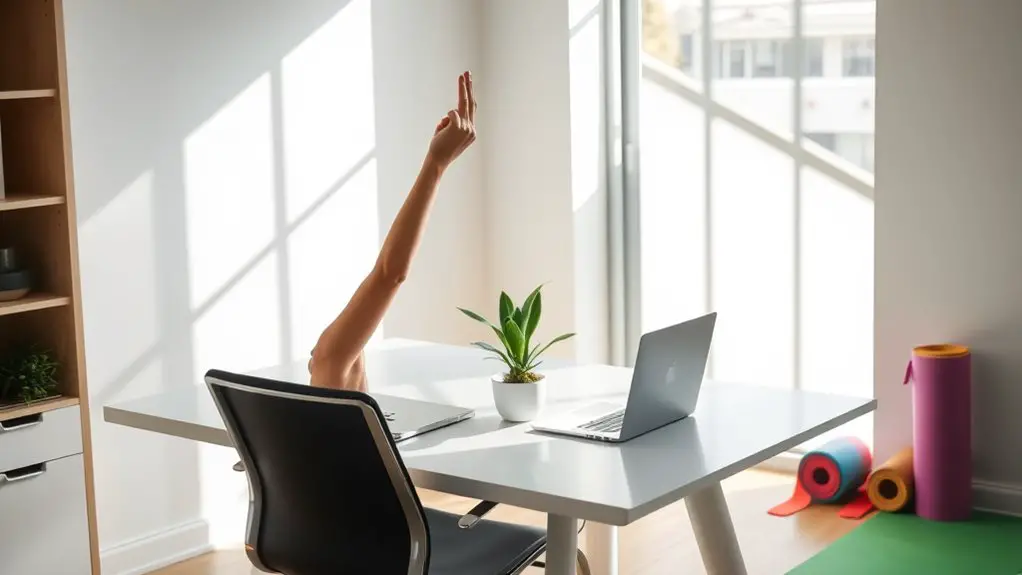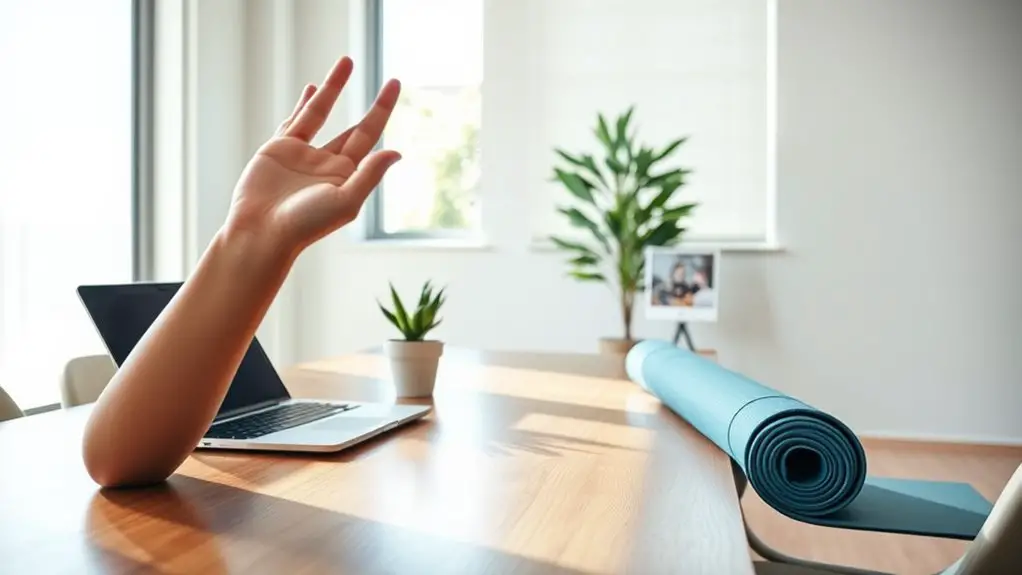Incorporating 10-minute stretches into your daily desk routine can boost your well-being and productivity. These stretches enhance circulation, relieve tension, and improve flexibility—keeping both your body and mind active. Try upper body stretches like shoulder rolls or chest stretches, and lower body moves such as seated leg stretches. You can fit these in throughout the day, especially after long tasks or at the end of your workday. There's more to discover about effective stretches that can make a difference!
Key Takeaways
- Incorporate upper body stretches like shoulder rolls and triceps stretches to alleviate tension and improve circulation.
- Include lower body stretches, such as hip flexion and seated leg stretches, to enhance flexibility and reduce strain.
- Aim for morning stretches to set a positive tone and post-lunch stretches to combat afternoon lethargy.
- Dedicate a few minutes after long tasks to refresh focus and relieve built-up stress.
- Regular stretching routines can significantly improve posture, reduce injury risk, and enhance overall well-being.
Benefits of Incorporating Desk Stretches

Incorporating desk stretches into your daily routine can greatly enhance your overall well-being. These simple movements break up long periods of sitting and promote better circulation, helping to reduce fatigue and increase energy levels. Regular movement is crucial for maintaining your health, as it helps combat the negative effects of prolonged sitting.
You'll find that stretching can alleviate tension in your neck, shoulders, and back, which often builds up during work hours. Improved flexibility and range of motion can also result from regular stretching, making daily tasks easier and more comfortable. Additionally, taking a few moments to stretch can boost your mood and mental clarity, allowing you to stay focused and productive. By prioritizing these stretches, you not only invest in your physical health but also improve your overall work experience.
Types of Effective Desk Stretches
Desk stretches come in various forms, each targeting different areas of the body to relieve tension and enhance flexibility. Incorporating these stretches into your day can help you feel more relaxed and energized. Regular stretching can significantly reduce musculoskeletal disorders caused by long hours of sitting.
| Upper Body | Lower Body |
|---|---|
| Shoulder Shrugs | Hip Flexion Stretches |
| Triceps Stretches | Knee Lifts |
| Arm Circles | Seated Leg Stretch |
| Neck Rolls | Calf Raises |
| Latissimus Stretches | Seated Figure-Four Stretch |
Integrating torso, core, wrist, and hand stretches can also improve your overall posture. A few minutes of these stretches can make a significant difference in how you feel throughout your workday. So, take a moment, stretch, and rejuvenate!
Best Times to Fit in Desk Stretches

Timing your desk stretches can make a significant difference in how you feel throughout the day. To combat monotony, incorporate stretches strategically.
Start your day with morning stretches to prevent fatigue and set a positive tone. After lunch, stretch to aid digestion and shake off lethargy. Following long tasks, take a moment to relieve stress and refresh your focus. Before meetings, a few stretches can enhance your mental clarity. Additionally, integrating stretches into your routine can improve overall body comfort and reduce tension.
As the day winds down, stretching helps release tension built up from prolonged sitting. Setting reminders can guarantee you stretch consistently, ideally every 5-10 minutes.
Essential Equipment for Desk Stretches
To make the most of your desk stretches, having the right equipment is essential. You don't need much to get started, but a few items can enhance your experience. A sturdy office chair and enough desk space will allow you to move freely. If you want to add resistance, consider using resistance bands or soft supports for cushioning. An adjustable desk can also help maintain proper posture. Taking frequent breaks for physical activity can significantly improve comfort levels during work.
Here's a quick overview of essential equipment:
| Equipment | Purpose |
|---|---|
| Office Chair | Provides support during stretches |
| Desk Space | Allows free movement of arms/legs |
| Resistance Bands | Adds resistance to stretches |
With these basics, you're ready to stretch effectively!
Health Improvements From Regular Stretching

Incorporating regular stretching into your daily routine can lead to significant health improvements. It enhances your flexibility, making daily activities easier while delaying the aging effects on mobility. Improved flexibility also boosts your physical performance and reduces injury risk. Additionally, stretching can reduce the risk of injuries by preparing your muscles for the demands of daily activities.
You'll notice better posture, as stretching balances muscle groups and reduces muscle strain. Additionally, stretching enhances blood flow, delivering essential oxygen and nutrients to your muscles, promoting faster recovery and reducing cramps. It helps remove waste products, creating a healthier internal environment and boosting endorphin levels for a better mood. Regular stretching also alleviates stress, promotes relaxation, and improves mental clarity, allowing you to focus better throughout your day.
Prioritizing these simple stretches can transform your overall health.
Tips for Making Desk Stretches a Habit
While it might seem challenging to make desk stretches a regular part of your day, establishing a routine can greatly enhance your well-being. Start by setting reminders on your phone to prompt you throughout the day. Begin with short stretches and gradually increase their duration as you gain flexibility. To keep things interesting, incorporate a variety of stretches targeting different muscle groups. For example, consider adding the Seated Mobility Exercise to help improve thoracic spine extension and relieve tension. Involve coworkers to create a supportive environment and schedule specific stretch breaks. Use shifting moments, like switching tasks, to fit in quick stretches. Make sure your desk setup promotes good posture and makes stretching easy. Sharing the benefits with colleagues can boost motivation and participation, helping everyone embrace this healthy habit.
Seated Twist: A Simple Stretch for Your Back
If you're looking for a simple yet effective way to relieve tension in your back, the seated twist is a perfect choice. This stretch engages your spine, upper back, hips, neck, and arms, making it ideal for anyone who sits for long periods. Additionally, this exercise primarily targets rotatores lumborum, which helps to improve spinal mobility and reduce tension from static positions.
Here's how to do it:
- Sit with your feet flat on the ground.
- Hold the chair with one hand and your opposite knee with the other.
- Inhale to lengthen your spine, then exhale as you twist.
- Look behind or over your shoulder during the twist.
- Hold for about 10-15 seconds, breathing deeply.
Incorporating this stretch into your day can improve posture, enhance flexibility, and help relieve stress.
Give it a try!
Shoulder Rolls: Relieving Upper Body Tension
Shoulder rolls are a simple yet effective way to relieve tension in your upper body. By incorporating this stretch into your daily routine, you can improve posture and boost productivity. Additionally, performing shoulder rolls can help alleviate discomfort caused by prolonged desk work and repetitive movements associated with typing. Let's explore the benefits, how to perform them, and tips for making them a regular part of your day.
Benefits of Shoulder Rolls
When you feel tension creeping into your shoulders, a few simple shoulder rolls can provide immediate relief. Incorporating this quick exercise into your day can lead to several benefits that improve both your physical and mental well-being:
- Improves flexibility: Increases shoulder joint flexibility and range of motion. Performing shoulder rolls can also help relieve tension in the shoulder muscles.
- Reduces tension: Alleviates stiffness and tightness in the shoulders.
- Enhances circulation: Boosts blood flow and oxygen to shoulder muscles.
- Relaxes muscles: Calms the muscles, easing stress and emotional tension.
- Maintains posture: Helps prevent slumping and supports good spinal alignment.
Step-by-Step Guide
To relieve upper body tension effectively, follow this simple step-by-step guide for performing shoulder rolls.
Start by positioning your hands comfortably on your lap or knees to maintain balance. Inhale deeply, lifting your shoulders toward your ears. As you exhale, roll your shoulders back and down, feeling the release in your upper body.
Repeat this motion several times to maximize relaxation. Remember to keep your back straight throughout the process to enhance the effectiveness of the roll. Additionally, utilizing resources like Tummee.com's yoga sequencing platform can provide further guidance on effective stretches for your routine.
You can also try variations, like forward rolls or seated rolls, to further engage your muscles. Consistent practice will improve your flexibility and help manage tension throughout your day.
Enjoy the benefits of this quick and easy stretch!
Incorporating Into Routine
Incorporating shoulder rolls into your daily routine can greatly enhance your comfort and productivity at work. By taking just a few moments to perform this simple exercise, you can relieve tension in your upper body and promote better posture. Aim to do shoulder rolls several times throughout your day, especially during long periods of sitting.
- Engages the muscles between your shoulder blades
- Improves circulation and reduces muscle strain
- Encourages relaxation and stress relief
- Aligns your shoulder blades to enhance posture
- Can be done while sitting or standing, making it convenient
- Regular stretching enhances mental well-being, supporting your overall productivity levels.
Make shoulder rolls a regular part of your workday to cultivate a healthier, more productive environment. Your body will thank you!
Chest Stretch: Opening Up for Better Posture
A chest stretch can be a game-changer for your posture and overall well-being. By opening up the chest and shoulders, you can reduce tension and improve flexibility, which helps prevent chronic pain. Good posture requires continuous awareness and practice, so incorporating these stretches into your daily routine is essential for long-term benefits. Let's explore how to perform these stretches effectively and make them a part of your daily routine.
Benefits of Chest Stretch
While many people spend hours hunched over desks, incorporating chest stretches into your routine can greatly improve your posture and overall well-being.
Regularly performing these stretches helps alleviate muscle tightness, counteract rounded shoulders, and enhance your mobility. You'll notice a significant reduction in discomfort and strain on your neck and back. Additionally, regular stretching promotes pain-free movement patterns which can further enhance your daily activities.
Additionally, improved chest expansion can lead to better breathing patterns.
- Reduces muscle tightness from prolonged sitting
- Promotes better posture by countering rounded shoulders
- Increases flexibility and range of motion
- Alleviates discomfort and pain associated with tight muscles
- Offers a boost in energy and mood throughout the day
How to Perform
To perform the chest stretch effectively, start by sitting tall in your chair with your back straight and arms extended out to the sides or at a 45-degree angle.
Make sure your shoulders are relaxed and dropped to avoid tension. Engage your shoulder muscles by drawing them back and down to activate the stretch.
Hold this position for 30 seconds, breathing deeply to enhance relaxation. If your arms aren't set at a specific angle, move them in small circles to increase the stretch.
You can also modify the stretch by switching arm positions or adjusting the angle for comfort.
For added support, consider using a wall or foam roller to deepen the stretch.
Tips for Effectiveness
Incorporating effective chest stretches into your daily routine not only enhances flexibility but also supports better posture. To maximize the benefits of these stretches, keep the following tips in mind:
- Perform stretches regularly: Aim for short sessions every hour to combat prolonged sitting.
- Tailor to your needs: Choose stretches that suit your flexibility level for ideal results.
- Focus on breathing: Inhale deeply during stretches to increase relaxation and effectiveness.
- Set reminders: Use alarms or calendar alerts to guarantee you don't skip your stretching routine.
- Pair with movement: Combine stretching with brief walks to enhance blood flow and reduce muscle tension. Incorporating stretch training into your routine can help significantly reduce musculoskeletal complaints experienced from prolonged sitting.
Frequently Asked Questions
How Long Should Each Desk Stretch Last?
Each desk stretch should last between 5 to 30 seconds, depending on the type. Aim for 10 to 30 seconds for static stretches, while dynamic ones may not require holding at all.
Can Desk Stretches Help With Anxiety?
Yes, desk stretches can help with anxiety. They promote mindfulness, release endorphins, and relax muscles, reducing tension. Regularly incorporating these stretches into your routine can greatly improve your mental well-being and lower stress levels.
Are There Any Risks Associated With Desk Stretching?
Yes, there are minimal risks associated with desk stretching. If you stretch improperly or have pre-existing injuries, you might experience discomfort. Always use proper technique, listen to your body, and stop if any pain occurs.
Can I Do These Stretches in a Meeting?
Yes, you can do these stretches in a meeting. Just focus on subtle movements like neck rolls or wrist stretches. They'll help you stay relaxed without distracting others or drawing attention to yourself.
How Often Should I Stretch During the Day?
You should stretch every 20-30 minutes during your workday. Each session can last 1-2 minutes, focusing on different muscle groups to improve flexibility, reduce fatigue, and enhance your overall well-being.
